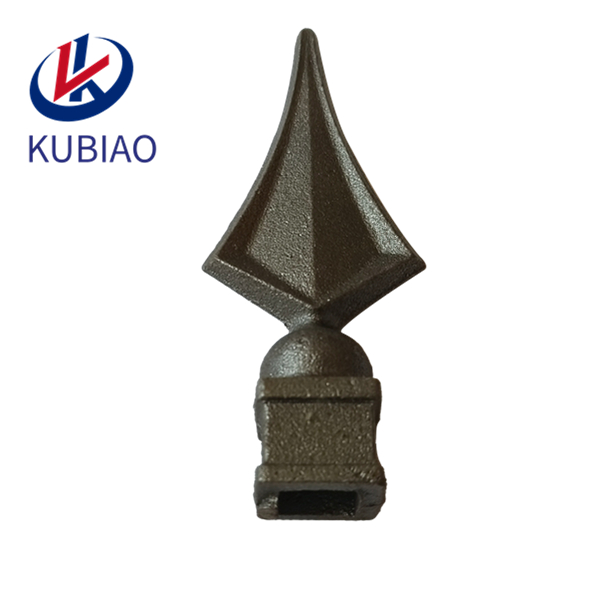
Cast iron spear SP-E013
Size: □1/2" 118X47
□5/8" 118X47
Material: Cast Grey Iron
Application: Iron fence gate decoration
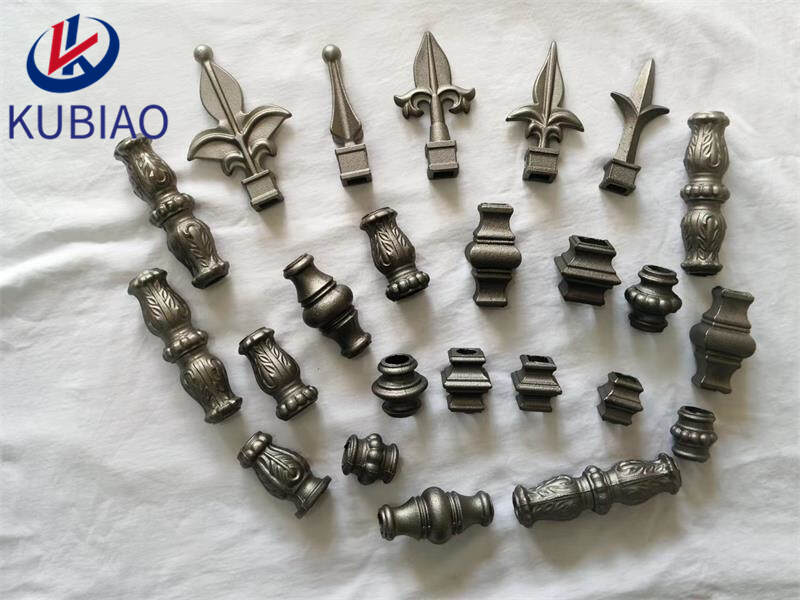
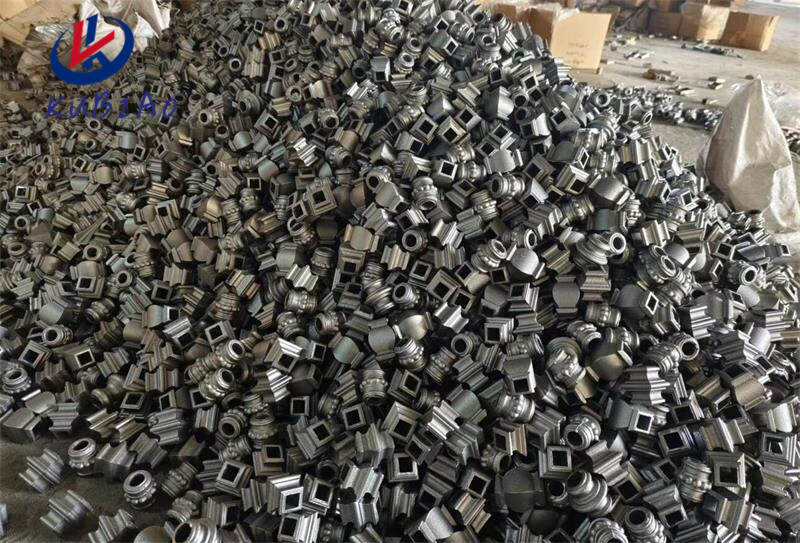
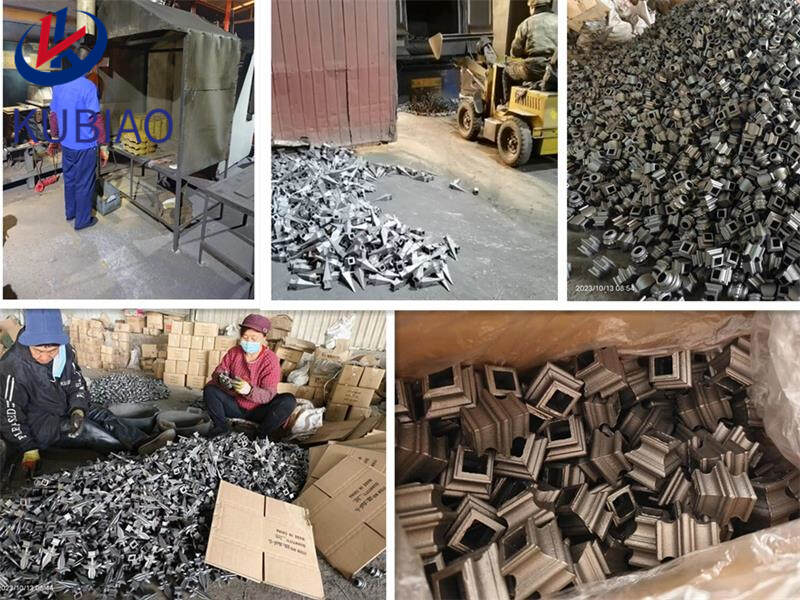
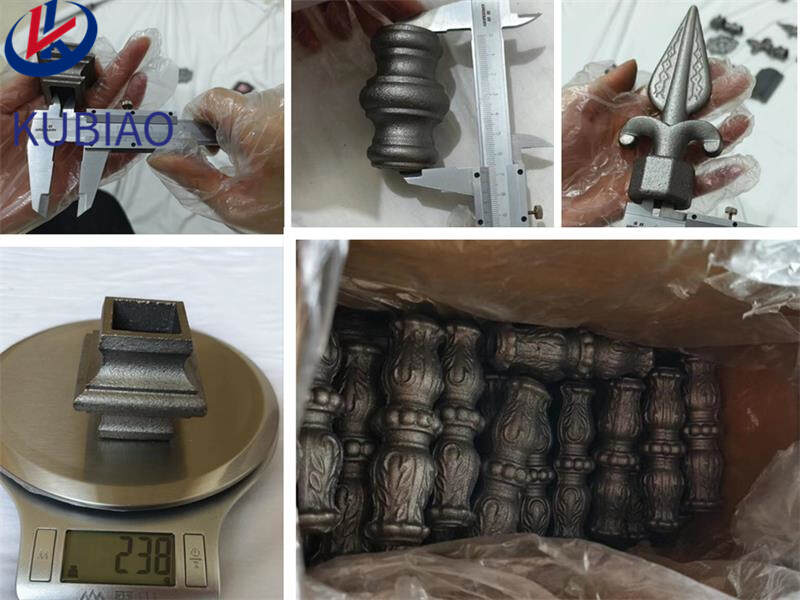
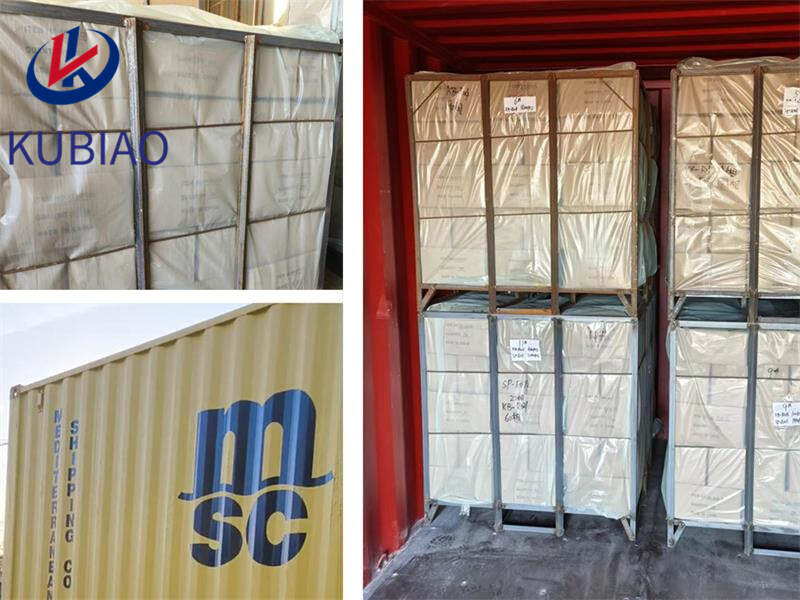
|
Product name |
ornamental iron components |
|
Keyword |
iron decor ,decorative fence stud ,decorative fence parts ,cast iron rosettes ,iron cast decorations |
| Place of Origin | China |
|
Quality standard |
We have our own professional QC team to insure the quality. |
|
Feature |
Cast iron is a strong metal material that can withstand large amounts of pressure and weight. It is also durable and resistant to corrosion, making it ideal as a decorative item |
|
Application scope |
Tea room, etc. |
|
surface treatment |
sand blasting antirust antirust oil/water painting hot dip galvanizing |
|
Unit Weight(g) |
448(Contact us for specific information to confirm) |
|
terms of payment |
50% T/T in advance, balance before shipment. |
|
Life span |
24 years (Contact us for specific information to confirm) |
|
delivery time |
It usually takes 40 days. |
|
Advantage |
We keep good quality and competitive price to ensure our customers benefit |
|
Packing |
17x9.05x7.9cm(Contact us for specific information to confirm) |
|
OEM/ODM |
Customization Service Provided |
|
design |
beautiful elegance sleek pretty |
|
Sales country |
All over the world for example:San Marino,Nepal,Reunion,Djibouti,Romania,Tokelau,Armenia |
|
MOQ |
222pcs(Contact us for specific information to confirm) |
About Us
SHIJIAZHUANG KUBIAO TRADING CO.LTD.is a manufacturer who produce various kinds of ornamental products, various kinds of hardware products. We have 18 years' experience in producing these kinds of goods, such as cast iron, wrought iron scrolls, baskets,gate cast iron parts ,ornamental iron fence finials,ornamental fence parts ,decorative iron ornament ,cast iron fence collar ,ornamental cast iron rosettes, gates and casted steel leaves & flowers.
Through careful market research, we constantly develop new products, improve the production process of products, to provide customers with quality service. Through honest cooperation, we have established good trade partnership with customers.
Our products are mainly exported to Europe, San Marino,Nepal,Reunion,Djibouti,Romania,Tokelau,Armenia, Japan and other areas.We make the best goods for all customers. We supply the best services to all customers. We hope to develop with all customers together step by step.
1.Are ornamental iron components suitable for indoor use?
We have been working hard to improve service quality and meet customer needs.
Yes, cast iron ornaments can be suitable for indoor use. However, they may require regular maintenance to prevent rusting and should be kept away from moisture. It is also important to ensure that they are properly secured to prevent any accidents.
2.Are there any health hazards associated with ornamental iron components ?
We focus on our customers' needs and strive to meet their expectations, so we take this very seriously.
There are no known health hazards associated with cast iron ornaments. However, if the ornaments are painted or coated with a sealant, there may be potential health risks from the chemicals used in these products. It is important to follow proper safety precautions when handling and using any type of paint or sealant. Additionally, if the ornaments are rusty or corroded, there may be a risk of tetanus if someone were to get cut or punctured by the metal. It is always a good idea to wear gloves and handle rusty or sharp objects with caution.
3.How long do ornamental iron components typically last?
We attach importance to the innovation ability and team spirit of employees, have advanced R & D facilities and laboratories, and have a good quality management system.
Cast iron ornaments can last for decades or even centuries if they are properly cared for and maintained. However, their lifespan can vary depending on factors such as exposure to harsh weather conditions, regular cleaning and maintenance, and the quality of the cast iron itself. With proper care, cast iron ornaments can last for generations.
4.What is the history of ornamental iron components ?
We pay attention to the introduction and training of talents, scientifically regulate the management system, and focus on cultural construction and team cohesion.
Cast iron ornaments have a long and rich history dating back to ancient civilizations. The use of cast iron for decorative purposes can be traced back to the 5th century BC in China, where it was used to create intricate and ornate objects such as bells and statues.
In Europe, the use of cast iron for decorative purposes began in the 15th century, with the production of cast iron firebacks and grates for fireplaces. These were often adorned with intricate designs and patterns, and were considered a symbol of wealth and status.
During the Industrial Revolution in the 18th and 19th centuries, cast iron became more widely available and affordable, leading to an increase in its use for decorative purposes. Cast iron ornaments were used to decorate buildings, parks, and gardens, and were also popular as household items such as door knockers, garden furniture, and garden urns.
In the late 19th and early 20th centuries, the Victorian era saw a surge in the popularity of cast iron ornaments. The ornate and elaborate designs of the Victorian era were perfectly suited to the versatility of cast iron, and it was used extensively in the construction of buildings, bridges, and other structures.
However, with the advent of new materials such as steel and aluminum, the use of cast iron for decorative purposes declined in the 20th century. It was not until the lat<
br> 20th century that there was a renewed interest in cast iron ornaments, with a growing appreciation for their historical and aesthetic value.
Today, cast iron ornaments are still used to decorate buildings, parks, and gardens, and are also popular as collectibles and antiques. They are valued for their durability, intricate designs, and historical significance, and continue to be a popular choice for adding a touch of elegance and charm to any space.
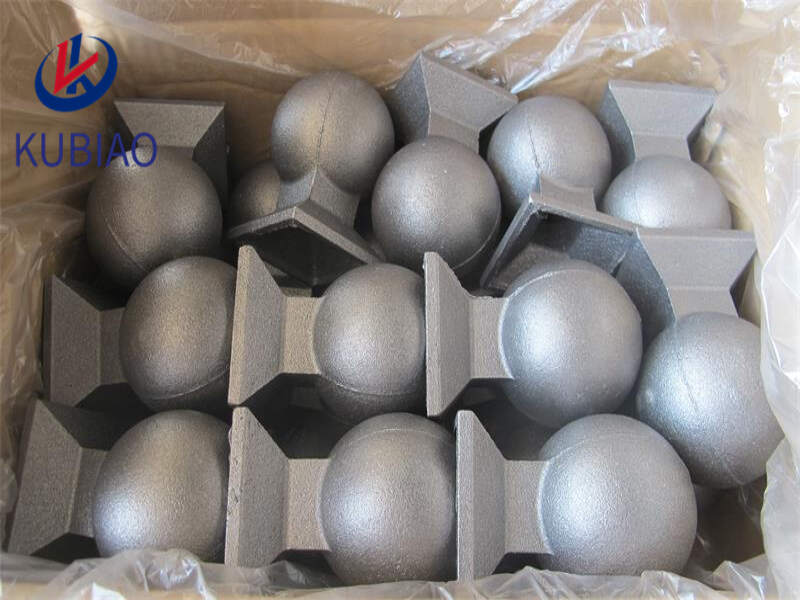
5.How do I properly hang or display ornamental iron components ?
We have a wide range of ornamental iron components customer groups and establishes long -term cooperative relationships with partners. The countries we provide services include San Marino,Nepal,Reunion,Djibouti,Romania,Tokelau,Armenia.
1. Choose a sturdy and secure location: Cast iron ornaments can be heavy, so it is important to choose a location that can support their weight. Avoid hanging them on weak or flimsy surfaces.
2. Use appropriate hardware: Make sure to use strong and durable hardware, such as heavy-duty hooks or screws, to hang your cast iron ornaments. Avoid using adhesive hooks or tape, as they may not be strong enough to hold the weight.
3. Consider the weather: If you are hanging your cast iron ornaments outdoors, make sure to use weather-resistant hardware and consider the elements. For example, if you live in a windy area, you may need to use additional hardware or secure the ornament with wire to prevent it from falling.
4. Use a level: Before hanging your ornament, use a level to ensure it is straight and even. This will help prevent it from tilting or falling off the wall.
5. Hang with care: When hanging your ornament, make sure to handle it with care to avoid damaging it. If the ornament has delicate or intricate details, use a soft cloth or gloves to handle it.
6. Display on a stand: If you prefer not to hang your cast iron ornament, you can also display it on a stand or shelf. Make sure the stand is sturdy enough to support the weight of the ornament.
7. Group similar ornaments together: If you have multiple cast iron ornaments, consider grouping them together for a cohesive display. This can also help distribute the weight evenly and prevent any one ornament from becoming too heavy for the display surface.
8. Regularly check for damage: Cast iron ornaments can be prone to rust and corrosion, especially if displayed outdoors. Make sure to regularly check for any signs of damage and address them promptly to prevent further deterioration.
6.Can ornamental iron components be used in both traditional and modern decor styles?
We maintain a certain amount of R&D investment every year and continuously improve operational efficiency to provide better services to our cooperative customers.
Yes, cast iron ornaments can be used in both traditional and modern decor styles. They can add a touch of vintage charm to traditional decor, while also bringing a bold and industrial element to modern decor. The versatility of cast iron ornaments allows them to be incorporated into a variety of design styles, making them a popular choice for home decor.
7.What are the benefits of using ornamental iron components in decor?
ornamental iron components is not a product only, but also can help you comes to money-making.
1. Durability: Cast iron is a strong and durable material that can withstand harsh weather conditions and last for many years without losing its shape or color.
2. Versatility: Cast iron ornaments come in a variety of shapes, sizes, and designs, making them suitable for various decor styles and themes.
3. Timeless appeal: Cast iron has been used in decor for centuries, and its classic and elegant look never goes out of style.
4. Low maintenance: Cast iron ornaments require minimal maintenance, making them a practical choice for busy homeowners.
5. Adds character: The intricate designs and details of cast iron ornaments can add character and charm to any space.
6. Affordable: Cast iron ornaments are relatively affordable compared to other decorative materials, making them a budget-friendly option for home decor.
7. Indoor and outdoor use: Cast iron ornaments can be used both indoors and outdoors, making them a versatile choice for decorating any space.
8. Rust-resistant: Most cast iron ornaments are treated with a rust-resistant coating, making them suitable for outdoor use without worrying about corrosion.
9. Eco-friendly: Cast iron is a sustainable and eco-friendly material, making it a popular choice for those looking for environmentally friendly decor options.
10. Customizable: Cast iron ornaments can be customized to fit specific design preferences, making them a unique and personalized addition to any space.
8.Are there any eco-friendly options for ornamental iron components ?
We are committed to providing personalized solutions and established long -term strategic cooperative relationships with customers.
Yes, there are several eco-friendly options for cast iron ornaments:
1. Recycled Cast Iron: Look for cast iron ornaments that are made from recycled materials. This reduces the need for new resources and helps to minimize waste.
2. Sustainable Production: Some companies use sustainable production methods, such as using renewable energy sources and minimizing water usage, to create their cast iron ornaments.
3. Organic Coatings: Instead of traditional paint or varnish, some cast iron ornaments are coated with organic materials, such as linseed oil or beeswax, which are more environmentally friendly.
4. Fair Trade: Look for cast iron ornaments that are certified as fair trade, meaning they are produced in an ethical and sustainable manner, and workers are paid fair wages.
5. Vintage or Secondhand: Consider purchasing vintage or secondhand cast iron ornaments instead of new ones. This reduces the demand for new production and gives new life to old items.
6. DIY: If you have some basic metalworking skills, you can create your own cast iron ornaments using recycled materials or scrap metal.
7. Upcycled: Some companies specialize in upcycling old cast iron items, such as old radiators or pipes, into unique and eco-friendly ornaments.
8. Biodegradable Packaging: When purchasing cast iron ornaments, look for companies that use biodegradable or recyclable packaging materials to reduce waste.
9. Local Production: Choosing cast iron ornaments that are locally produced reduces the carbon footprint associated with transportation and supports your local economy.
10. Longevity: Cast iron ornaments are known for their durability and longevity. By choosing high-quality, long-lasting ornaments, you can reduce the need for frequent replacements and ultimately reduce waste.
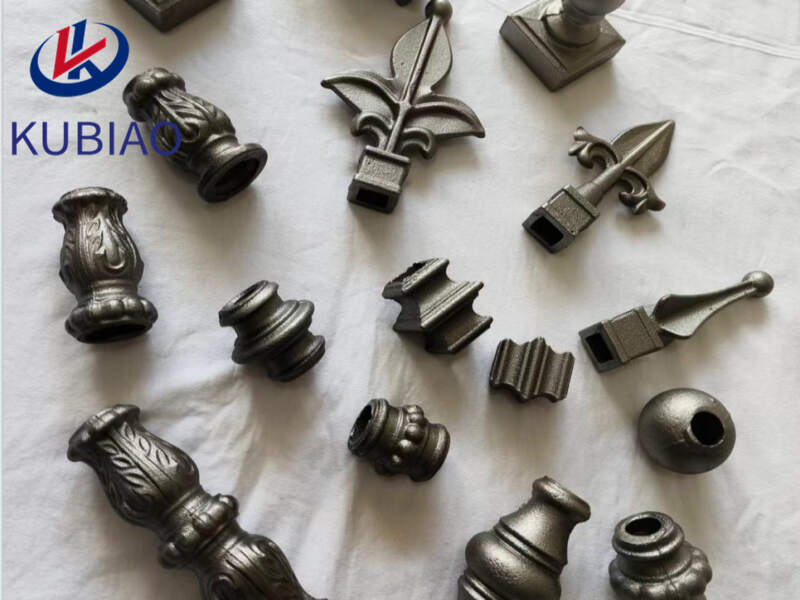
9.Are ornamental iron components easy to install?
We should have a stable supply chain and logistics capabilities, and provide customers with high -quality, low -priced ornamental iron components products. It depends on the specific ornament and the installation method. Some cast iron ornaments may be easy to install with simple screws or brackets, while others may require more complex installation techniques such as drilling or welding. It is important to carefully read the installation instructions and have the necessary tools and skills before attempting to install a cast iron ornament.
10.Are there any common design elements found in ornamental iron components ?
1. Intricate Details: Cast iron ornaments often feature intricate and detailed designs, such as floral patterns, scrollwork, and geometric shapes.
2. Curved and Organic Shapes: Many cast iron ornaments have curved and organic shapes, which are achieved through the casting process.
3. Symmetry: Symmetry is a common design element in cast iron ornaments, with designs often being mirrored on both sides.
4. Repetition: Many cast iron ornaments feature repeated patterns or motifs, creating a sense of unity and cohesion in the design.
5. Textures: Cast iron ornaments can have a variety of textures, including smooth, rough, and hammered surfaces, adding visual interest and depth to the design.
6. Finials and Fleur-de-lis: Finials, which are decorative end pieces, and fleur-de-lis, a stylized lily flower, are commonly found in cast iron ornaments, adding a touch of elegance and sophistication.
7. Gothic and Victorian Influences: Cast iron ornaments often draw inspiration from Gothic and Victorian architecture, featuring pointed arches, spires, and intricate details.
8. Natural Elements: Many cast iron ornaments incorporate natural elements, such as leaves, flowers, and animals, into their designs.
9. Rustic and Industrial Aesthetics: Cast iron ornaments can also have a rustic or industrial aesthetic, with rough textures and simple, geometric designs.
10. Black or Dark Colors: Due to the nature of cast iron, most ornaments are black or dark in color, adding a sense of drama and contrast to the design.
11.How are ornamental iron components made?
We continue to improve ornamental iron components products and processes to improve efficiency.
1. Creating a Design: The first step in making cast iron ornaments is to create a design. This can be done by hand-drawing or using computer-aided design (CAD) software.
2. Making a Mold: Once the design is finalized, a mold is created. This can be made from wood, metal, or other materials. The mold is usually made in two halves, with the design carved or etched into it.
3. Preparing the Iron: Cast iron is made by melting iron and adding other elements such as carbon, silicon, and manganese to create a strong and durable material. The iron is heated in a furnace until it reaches a molten state.
4. Pouring the Iron: Once the iron is molten, it is poured into the mold. The mold is usually preheated to prevent the iron from cooling too quickly and to ensure a smooth finish.
5. Cooling and Removal: The iron is left to cool and solidify in the mold. Once it has cooled, the mold is opened and the cast iron ornament is removed.
6. Finishing: The cast iron ornament may have rough edges or imperfections from the casting process. These are removed by grinding, sanding, or filing. The ornament may also be polished or painted to achieve the desired finish.
7. Inspection: The finished ornament is inspected for any defects or imperfections. Any necessary touch-ups or repairs are made at this stage.
8. Packaging and Shipping: The final step is to package the cast iron ornament for shipping or display. This may involve adding protective packaging or attaching hanging hardware if necessary.
Welcome to contact us for Cast Iron Order!
Email: sales@kubiaometal.com
Cellphone/Whatsapp: 0086 13020588163
Wechat: 13028588163
Tag:casting spearheads,4x4 cast iron post caps,fence bases,iron garden ornament ,decorative fence leaf,iron leaf ornament,casting spears,cast iron gate ornaments
PREV: ornamental iron fence finials
NEXT: ornamental fence spears
Product
Category